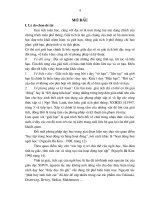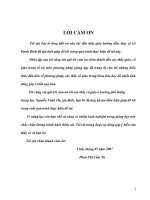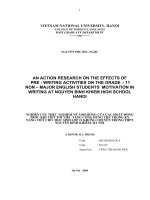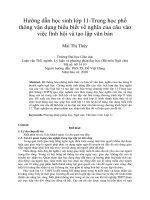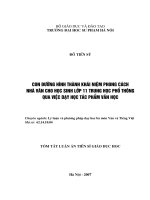PHONG CÁCH HỌC NGOẠI NGỮ CỦA HỌC SINH LỚP 11, NAM ĐỊNH
Bạn đang xem bản rút gọn của tài liệu. Xem và tải ngay bản đầy đủ của tài liệu tại đây (1.34 MB, 12 trang )
<span class='text_page_counter'>(1)</span><div class='page_container' data-page=1></div>
<span class='text_page_counter'>(2)</span><div class='page_container' data-page=2>
SỐ ĐẶC BIỆT CHÀO MỪNG KỶ NIỆM 10 NĂM THÀNH LẬP
KHOA NGOẠI NGỮ - ĐẠI HỌC THÁI NGUYÊN (2007 – 2017)
Môc lôc
Trang
TS. Lê Hồng Thắng - Bàn về dạy-học ngoại ngữ qua đề án dưới góc độ của giáo học pháp 3
Nguyễn Thị Như Nguyệt, Chu Thành Thúy - Đánh giá năng lực đầu ra tiếng Nga của sinh viên trình độ
A2-B1 theo khung tham chiếu chung châu Âu tại Khoa Ngoại ngữ - Đại học Thái Nguyên 7
Nguyễn Thùy Linh - Kiểm tra đánh giá trong giảng dạy các môn đề án ngôn ngữ - một số chia sẻ từ thực tế 13
Vũ Thị Thanh Huệ - Nhận thức của sinh viên đối với khóa đọc mở rộng trực tuyến với sự trợ giúp của mạng xã
hội Edmodo 19
Mai Thị Thu Hân, Nguyễn Thị Liên, Hoàng Thị Tuyết, Dương Thị Ngọc Anh - Tăng cường tính tự học bằng
dự án học tập - nghiên cứu tình huống tại trường Đại học Hoa Lư 25
Dương Đức Minh, Dương Lan Hương - Nghiên cứu về sự tương tác giữa người thuyết trình và khán giả khi học
<i>kỹ năng thuyết trình của sinh viên chuyên ngành tiếng Anh tại Khoa Ngoại ngữ - Đại học Thái Nguyên </i> 31
Phạm Thị Kim Uyên - Sử dụng nhật ký trong dạy biên dịch cho sinh viên chuyên ngữ Đại học Nha Trang 37
Lê Thị Hồng Phúc - Phản hồi của sinh viên về dự án TV show lấy điểm cuối kỳ trong khóa ngữ âm 43
Hán Thị Bích Ngọc - Dạy học ngoại ngữ bên ngồi lớp học - ứng dụng mạng xã hội facebook trong dạy và học
tiếng Anh 49
Nguyễn Ngọc Lưu Ly, Quách Thị Nga - Vài nét về việc sử dụng truyền thông đa phương tiện trong giảng dạy
tiếng Trung Quốc trình độ sơ cấp tại Khoa Ngoại ngữ - Đại học Thái Nguyên 55
Lê Thị Hòa, Đậu Thị Mai Phương - Nâng cao kỹ năng thế kỷ 21 trong học tiếng Anh chuyên ngành thông qua
dự án 61
Nguyễn Thị Bích Ngọc, Trần Minh Thành - Phương pháp gia tăng hiệu quả của đề án tạp chí tiếng Anh trong
việc học viết cho sinh viên chuyên ngành tiếng Anh tại Khoa Ngoại ngữ - Đại học Thái Nguyên 67
Hoàng Thị Huyền Trang, Nguyễn Thị Ngọc Anh - Phát triển khả năng đọc hiểu tiếng Anh cho sinh viên ngoại
ngữ thơng qua các bài đọc có nội dung bao hàm yếu tố văn hóa phù hợp 73
Nguyễn Quốc Thủy,Nguyễn Thị Đoan Trang - Dạy - học ngoại ngữ qua đề án tạp chí tại trường Đại học Sư
phạm – Đại học Thái Nguyên 79
Nguyễn Tuấn Anh - Thiết kế tổ chức dạy học môn báo chí trực tuyến theo hướng học ngơn ngữ qua dự án như
một cách đảm bảo tính đa ngành của chương trình đào tạo 85
Đỗ Thị Sơn, Đỗ Thị Phượng - Nghiên cứu phân tích lỗi sai của sinh viên Khoa Ngoại ngữ - Đại học Thái
Nguyên khi dịch trực tiếp từ Hán Việt sang tiếng Trung Quốc và giải pháp khắc phục 91
Trần Đình Bình - Ứng dụng phương pháp dạy học qua dự án trong dạy học ngoại ngữ ở Việt Nam 97
Lê Thị Khánh Linh, Lê Thị Thu Trang - Phương tiện biểu đạt thái độ của người kể chuyện trong các chương
<i>trình talk show của Mỹ và Việt Nam </i> 103
Đỗ Thanh Mai, Phùng Thị Thu Trang - Ứng dụng Moodle trong dạy và học trực tuyến học phần tin học đại
cương tại Khoa Ngoại ngữ - Đại học Thái Nguyên 109
Mai Thị Ngọc Anh, Vi Thị Hoa, Phạm Hùng Thuyên - Vận dụng phương pháp dạy học theo dự án trong giảng
dạy môn tiếng Trung du lịch tại Khoa Ngoại ngữ - Đại học Thái Nguyên 117
Trần Thị Hạnh - Nhận thức của sinh viên về việc ứng dụng Edmodo như một công cụ phụ trợ trong học tập 123
Bùi Thị Ngọc Oanh - Cải thiện kỹ năng nói của sinh viên khơng chun trình độ A2 với dạy học qua đề án 129
Journal of Science and Technology
174
(14)
</div>
<span class='text_page_counter'>(3)</span><div class='page_container' data-page=3>
Nguyễn Hạnh Đào, Đinh Nữ Hà My - Nghiên cứu tình huống về những khó khăn với người học và điều cần
lưu ý khi giảng dạy môn tiếng Anh chuyên ngành áp dụng phương pháp học qua dự án 135
Nguyễn Thị Kim Oanh - Sử dụng đường hướng học tập theo dự án cho môn học tiếng Anh chuyên ngành tại
Viện Ngoại ngữ, Đại học Bách Khoa Hà Nội: lợi ích, thách thức và đề xuất 141
Vũ Thị Kim Liên - Phát triển năng lực ngữ dụng của sinh viên trường Đại học Ngoại ngữ, Đại học Quốc gia
Hà Nội 147
Đàm Minh Thủy - Tích hợp kỹ năng trong học ngoại ngữ thông qua dự án làm video “Tìm hiểu ảnh hưởng của
văn hóa Pháp tại Việt Nam” 153
Nguyễn Thị Thu Hoài - Thực trạng thực tập giảng dạy tiếng Anh ở một số trường THPT tại thành phố Thái
<i>Nguyên và các đề xuất giải pháp </i> 159
Nguyễn Thị Ngọc Anh, Hoàng Huyền Trang - Khảo sát lỗi sai của sinh viên Trung Quốc khi học tiếng Việt
tại Khoa Ngoại ngữ - Đại học Thái Nguyên và những đề xuất khắc phục 165
Quách Thị Nga, Đỗ Thị Thu Hiền - Những vấn đề tồn tại của giáo trình đối dịch Trung - Việt ở Việt Nam hiện
nay và giải pháp khắc phục (khảo sát tại Khoa Ngoại ngữ - Đại học Thái Nguyên) 171
Phan Thanh Hải - Hướng tới một chương trình đào tạo cử nhân sư phạm tiếng Anh dựa trên các đề án học tập
trong đào tạo đại học định hướng thực hành ứng dụng nghề nghiệp 177
Lê Vũ Quỳnh Nga, Lý Thị Hoàng Mến, Nguyễn Thị Thu Oanh - Nâng cao chất lượng bài dịch của sinh viên
Khoa Ngoại ngữ - ĐHTN thông qua việc áp dụng phương pháp học tập hợp tác 183
Đoàn Thị Thu Phương - Phong cách học ngoại ngữ của học sinh lớp 11, Nam Định 189
</div>
<span class='text_page_counter'>(4)</span><div class='page_container' data-page=4>
LANGUAGE LEARNING STYLE PREFERENCES OF GRADE 11 STUDENTS
AT A HIGH SCHOOL, NAM DINH
Doan Thi Thu Phuong*
<i>University of Languages and International Studies, VNU </i>
SUMMARY
This paper studied the language learning style preferences (LLPs) of grade 11 students and
teachers’ awareness of them. 35 students and 2 teachers of English from group A at a high school,
Nam Dinh were called for cooperation. A 13-item LLP questionnaire adopted from Brindley
(1984) was adapted and employed. In addition, more in-depth dada was obtained through
interviews with both teachers and students, and diaries by students. Results showed (1) students
had their stronger preference for visual and auditory learning, and (2) teachers are well aware of
their students’ preferred styles in some cases, but unaware in others.
<i>Key words: learning styles, learning style preferences, learning habits, teaching styles, teaching </i>
<i>strategies </i>
INTRODUCTION *
In this rapidly growing society, English has
gained its importance, and has become a tool
or a demand of all professionals. English has,
therefore, taken the place of a compulsory
subject in high school’s curriculum in
Vietnam. However, English language
teaching at Vietnamese high schools seems
favor a teacher-centered and
grammar-translation method and an emphasis on rote
memory. As a result, many students after
graduating from high school can not
communicate with others in English or feel
too shy to do so. What may be the reasons for
this fact? The reasons may lie in numerous
factors including social factors, educational
factors, pupil factors, and teacher factors.
Pupils and teachers are undeniably the core
components of the teaching and learning
process; thus the harmony between the
learning styles of students and the teaching
strategies of the teacher should be taken into
great consideration. The inability to
communicate fluently and efficiently in
English among high school students partly
stems from the fact that teachers are unaware
of their students’ learning styles.
Consequently, they have chosen inappropriate
instructional strategies, which cause a
*
<i>Tel: 0917833348; Email: </i>
negative impact on the effectiveness of the
learning and teaching process.
</div>
<span class='text_page_counter'>(5)</span><div class='page_container' data-page=5>
<i> Đoàn Thị Thu Phương </i> Tạp chí KHOA HỌC & CƠNG NGHỆ 174(14): 189-195
190
METHODS
The subjects of the study include totally 35
students majoring in English at the age of 17,
including 30 females and 5 males, and 2
female teachers: one is 54 years old with 33
years of teaching English and the other is 26
years old with 4 years of teaching English.
Data collection instruments
Three data collation methods, i.e.
questionnaires, interviews and diaries, were
triangulated to provide reliable and valid data
for this study.
Two versions of questionnaire were revised
by the researcher with reference to 13-item
language learning preference questionnaires
adopted from [1]. In the students’ version, the
students were supposed to state how they
prefer to learn the language. In the teachers’
version, the teachers were asked to express
their opinions as to how they feel their
students prefer to learn the language. The
usefulness of questionnaires in investigating
learners’ language learning styles has been
proved by many previous studies including
[7], [8], [9] and [11],. Questionnaires were
also employed as the primary data collection
instrument in this study because “it is quite
labor-intensive in construction and analysis.
The knowledge needed is controlled by the
questions; therefore it affords a good deal of
precision and clarity” [5, p.171].
Diary was chosen as the second research
tool because this introspective method can
provide information about the inner
language learning process, which is
unlikely to be obtained by other means.
Gass and Mackey (2007) [4] claim that:
Diary is another means of obtaining
information about learners’ internal process.
In diary studies, learners are able to record
their impressions or perceptions about
language learning, unconstrained by
pre-determined areas of interests. Diaries can
yield insights into the learning process that
may be inaccessible from the researchers’
perspective alone. Even in studies that
provide a structure for the diary writers to
follow (e.g., certain topics to address and
guidelines for the content), researchers are
still able to access the phenomena under
investigation from a viewpoint other than
their own. (p.48)
McDonough (1997) [5] also points out that
diaries can record “what happened, what the
writer felt about it, what might or should have
happened, what could change, opinions,
anticipation and immediate reactions, as well
as more reflective tone” (p.124). The diary
entries then gave the researcher a more
insightful understanding of student’s learning
styles not just in class but also in their own
homes. Moreover, the diary instrument
hindered the potential of the researcher’s
misinterpretation because students’ learning
styles in class can be controlled by tasks
designed by the teachers and commonly to the
teacher’s own learning styles.
As a follow-up instrument, two versions of
semi-structured interview were designed; one
for students and one for teachers. As noted in
[6, p.60], “interviews can be used to
investigate a range of issues including
developmental aspects of learner language
and learning-style preferences.” Additionally,
both Nunan (1989) [6] and McDonough
(1997) [5] asserted that interviews can be
used in an “ancillary” role, perhaps as a
checking mechanism to triangulate data
gathered from other sources. Semi-structured
interviews were chosen because they allow
for greater flexibility (e.g. changing the order
of questions); for more extensive follow-up of
responses (e.g. asking some more in-depth
questions); and for richer interactions (e.g.
extending the length of the interview) rather
than interviews armed with entirely pre-coded
questions.
Data collection procedures
</div>
<span class='text_page_counter'>(6)</span><div class='page_container' data-page=6>
days, the researcher collected students’ diary
entries for the first time. Students were asked
to continue writing the learning diary, and
then after another 20 days all the diary entries
were collected. Finally, interviews were
conducted in Vietnamese after students and
teachers had completed the questionnaires
and students had written several learning
diary entries.
Data analysis procedures
Data collected from the questionnaires was
mathematically calculated and synthesized
from numbers into percentages. In the interest
of the comparison and generalization of the
received data, such statistics was summarized
into tables and bar charts regarding eight
equivalent items in students’ questionnaire
and teachers’ questionnaire. Additionally, two
more items on which English skills students
prefer to study (from the questionnaire) and
what is their most favorite English lesson
(from the diary) was also presented. Most
typical quotations from the interviews with
both students and teachers, and extracts from
the students’ learning diary entries were
frequently cited to illustrate the data analysis.
Finally, all the findings from the data
collected in the questionnaires, interviews and
diary entries were compared and contrasted
with the findings from previous studies
related to the research topic.
RESULTS AND DISCUSSIONS
Regarding students’ learning mode, it is
observed that the largest percentage of
students (82.85 %) expressed their preference
for working in small groups, which nearly
double those who preferred working
individually and working in one large group
(48.57 % and 37.14 %, respectively). One
major reason for this choice is that students
can share and exchange ideas in order to
come to the best decision. “When working in
small groups (3-5 members/ group), many
heads think about one matter at the same
time; there will be more ideas. If working
alone, there’ll be only one idea. Working in
pairs, if there is a disagreement, it’s hard to
make a compromise. When working in small
groups, the idea of the majority will be
chosen and normally it is the best decision”,
said student 1.
<i>Figure 1. Students’s learning mode </i>
2.86
2.86
5.72
2.86
48.57
28.57
11.43
60
48.57
68.57
82.85
37.14
Learning individually
Learning in pairs
Learning in small groups
Learning in one large group
Like Do not like Neutral
</div>
<span class='text_page_counter'>(7)</span><div class='page_container' data-page=7>
<i> Đoàn Thị Thu Phương </i> Tạp chí KHOA HỌC & CƠNG NGHỆ 174(14): 189-195
192
In their learning diary entries, students also
showed a great interest in group activities
conducted in class:
Jan 25th - “… the English lesson today is
more interesting with group work activity. I
like this kind of activity most because I can
remember the lesson longer. I’m so sorry that
today my group hasn’t got any points. The
teacher has suggested about group speaking
according to a topic. It sounds interesting. I’m
thinking about some special topics…”
(Student 4)
Feb 2nd - “…I felt great today. We worked in
groups, making a plan for a class picnic. My
group chose “Phu Giay” festival. When the
whole group was called to speak in front of
the class, I felt a bit scared but everything was
all right. So happy!” (Student 5)
Turning to working individually, students feel
irritated when they have to leave their work
unfinished because they can not ask other
classmates about what they have not
understood. One student remarked that it is
not worth working individually, especially
when they are given an interesting topic to
work on, because they do not have a chance
to exchange or share ideas with friends.
As a follow-up interview question for item 1
in the questionnaire, students were asked to
clarify what their favorite learning mode at
home and in class is. Most students preferred
to learn independently at home and work in
small groups in class. They said that the quiet
atmosphere within the space of their own
room facilitates them to concentrate on their
study, and they can do or learn whatever they
like without anyone’s interference. However,
some stated that learning by themselves
sometimes makes them bored or sleepy.
Therefore, if they can arrange appropriate
time and space, they would prefer working
with one close friend or a group of friends. In
terms of group work, 71.42 % students when
interviewed favored this work arrangement in
class because they can share and exchange
opinions together. For those, who are shy and
introvert, they feel more confident in
teamwork, where they dare to speak their
voice without fear. “When listening to the
ideas of my group members, I can learn many
interesting things from their way of thinking,
their way of giving opinions… If I make a
mistake, they can correct for me. I also feel
more confident when saying my opinions
within my group. Normally, I feel so shy that
I don’t dare to express myself in front of the
class”, said student 14. Overall, the majority
of the students showed their tendency towards
learning in pairs and in small groups. They
express their interest in teamwork and their
reluctance to work on their own. This finding
correlates with that in [9] concerning the
preference for group activities by Asian ESL
students and Iranian EFL learners.
</div>
<span class='text_page_counter'>(8)</span><div class='page_container' data-page=8>
The findings concerning all research items are illustrated in the following table.
Students Teachers
1. Learning mode <i>- For group work - 82.85 % </i>
<i>- Against individual work - 48.57 % </i>
Aware
2. Learning habits
- For being actively engaged in classroom activities.
<i>- For reading and taking notes - 57.14 % </i>
<i>- Against copying from the board - 85.71 % </i>
Unaware
Unaware
Aware
3. Vocabulary learning
strategies
<i>For translating into Vietnamese - 85.71 %, </i>
<i>guessing the unknown - 77.14 %, </i>
<i>thinking of words’ relationships - 74.28 % </i>
Aware
Aware
Unaware
4. Corrective feedback <i>For immediate corrections - 80 % </i> Aware
5. Learning materials <i>For the Internet, TV, movies, videos, pictures or posters - </i>
<i>97.14 % & 88.57 % </i>
Aware
6. Learning activities
- Against memorizing dialogues and writing a learning
<i>diary - 91.43 % & 74.29 % </i>
<i>- For having a native guest to class - 85.71 % </i>
Aware
Unaware
7. Means of assessment
<i>Being able to use English effectively in real-life situations - </i>
<i>85.71 % </i>
> being formally assessed by teachers through written tests
Unaware
8. Sense of satisfaction Performing successfully in the situations they used to find
<i>difficult - 100 % > getting good marks or being praised </i>
Unaware
9. English skills
<i>Productive skills </i>
<i>(speaking - 48.58 % & writing - 40 %) </i>
<i> > Receptive skills </i>
<i>(listening - 28.57 % & reading - 17.14 %) </i>
Unaware
10. Favourite English
lesson
<i>- T’s thorough explanation & friendly attitude </i>
<i>- The integration of games and speaking activities into the </i>
<i>lesson </i>
<i>- A suitable number of tests and exams </i>
Aware (to
a certain
extent)
CONCLUSION
In short, through conscientious analysis and
discussion of data collected from
questionnaires, interviews and diaries, some
major findings are summarized as follows:
1) Regarding the working arrangement,
students were keenly interested in group work
and reluctant to work independently, and
teachers could understand their students’
preferred style.
2) Students did not like to be sitting passively
in the classroom, but to be actively engaged
in the classroom activities. Teachers could
realize their students’ dislike for copying
from the board; however, they were not aware
of students’ preference for reading books and
taking notes by themselves.
3) Student’s most favoured vocabulary
learning strategies were translating words
from English into Vietnamese, guessing the
unknown, and thinking of the relationships
between known and unknown. Teachers had a
correct assumption about students’ preference
for verbatim translation; but wrongly thought
that their students were unwilling to think of
the relationships among words.
4) Being corrected immediately in front of the
class did not seem to bother students.
Correspondently, teachers often give students
immediate feedbacks rather than delayed ones.
5) The majority of the students seemed to be
visual learners with preferences for the
Internet, television, movies, videos, pictures
or posters, and teachers appeared to endorse
their students’ choices.
</div>
<span class='text_page_counter'>(9)</span><div class='page_container' data-page=9>
<i> Đồn Thị Thu Phương </i> Tạp chí KHOA HỌC & CÔNG NGHỆ 174(14): 189-195
194
have a native guest in their class, which
proves the students’ communicative approach
toward language learning. Nonetheless,
teachers did not seem to be aware of their
students’ tendency.
7) Contrary to the teachers’ expectation,
students preferred realizing their English
improvement through their ability to use
English effectively in real-life situations to
being formally assessed by their teachers
through written tests.
8) Against the teachers’ opinion, students got
a sense of satisfaction not just by getting good
marks or being praised, but by seeing if they
can perform successfully in the situations they
used to find difficult.
9) Students had greater interest in productive
skills (speaking and writing) than receptive
skills (listening and reading); however,
teachers wrongly assumed that their students
would feel reluctant to learn speaking or
writing skills.
10) Students felt satisfied with the teachers’
thorough explanation and friendly way of
delivering the knowledge, the integration of
games and speaking activities into the lesson,
and an appropriate number of tests and
exams. Nevertheless, teachers only met their
students’ expectations to a certain extent.
To sum up, with an effort to classify students
into different categories of learning styles,
students in Group A can be labelled as a
mixture of visual, auditory, tactile, kinesthetic
and group learners with a stronger preference
for visual and auditory learning. However,
only a small number of students and teachers
participated in this study, resulting in limited
pedagogical applications. Therefore, larger
samples would help to explore more in-depth
and reliable information about the preferred
language learning styles of grade 11 students.
Other researchers can choose to investigate
the learning styles of mainstream students
instead of gifted students (as in the case of
Group A). They may even conduct another
study comparing the language learning styles
of mainstream students with those of gifted
students. In another aspect, researchers may
make use of the results of this study to
conduct some studies as to the effect of
variables such as gender, age, level of English
proficiency, cultural influences on the
students’ choice of learning styles.
REFERENCES
<i>1. Brindley, G. (1984), Needs analysis and </i>
<i>objective setting in the adult migrant education </i>
<i>program, Sydney, NSW: Adult Migrant Education </i>
Service.
2. Dunn, R. (1984), “Learning style: State of the
<i>science”, Theory into Practice, 23 (1), pp.10-19. </i>
3. Friedman, P. & Alley, R. (1984), “Learning/
<i>Teaching styles: Applying the principles”, Theory </i>
<i>into Practice, 23 (1), pp.77-81. </i>
<i>4. Gass, S. & Mackey, A. (2007), Data elicitation </i>
<i>for second and foreign language research. New </i>
Jersey: Lawrence Erlbaum Associates.
5. McDonough, J. & McDonough, S. (1997),
<i>Research method for English language teachers. </i>
London: Arnold.
<i>6. Nunan, D. (1989), Understanding language </i>
<i>classrooms. New York: Prentice Hall. </i>
7. Ramburuth, P. & McCormick, J. (2001),
“Learning diversity in higher education: A
comparative study of Asian international and
<i>Australian students”, Higher Education, 42 (3), </i>
pp.333-350.
8. Reid, J. (1987), “The learning style preferences
<i>of ESL students’, TESOL Quarterly, 21(1), </i>
pp.87-111.
9. Riazi, A. & Riasati, M. J. (2007), “Language
learning style preferences: A students case study
<i>in Shiraz EFL institutes’, Asian EFl Journal, 9 (1), </i>
pp.97-125.
<i>10. Smith, L. H. & Renzulli, J. S. (1984), </i>
“Learning style preferences: A practical approach
<i>for classroom teachers”, Theory Into Practice, 18, </i>
pp.44-50.
</div>
<span class='text_page_counter'>(10)</span><div class='page_container' data-page=10>
TÓM TẮT
PHONG CÁCH HỌC NGOẠI NGỮ CỦA HỌC SINH LỚP 11, NAM ĐỊNH
Đoàn Thị Thu Phương*
<i>Trường Đại học Ngoại ngữ - ĐH Quốc gia Hà Nội </i>
Nghiên cứu này tìm hiểu phong cách học ngoại ngữ của học sinh lớp 11 và ý thức của giáo viên về
vấn đề này. Đối tượng nghiên cứu là 35 học sinh và 2 giáo viên tiếng Anh tại Nam Định. Công cụ
nghiên cứu gồm (1) Bảng khảo sát phong cách học ngôn ngữ của Brindley (1984), (2) Phỏng vấn
học sinh và giáo viên, và (3) Nhật ký học tập của học sinh. Kết quả nghiên cứu cho thấy (1) học
sinh thiên về cách học theo kênh hình và kênh tiếng, và (2) giáo viên hiểu rõ phong cách học của
học sinh ở một vài trường hợp.
<i>Từ khóa: phong cách học, phong cách học ưu tiên, thói quen học, phong cách dạy học, chiến lược </i>
<i>dạy học </i>
<i>Ngày nhận bài: 15/10/2017; Ngày phản biện: 12/11/2017; Ngày duyệt đăng: 13/12/2017 </i>
*
</div>
<span class='text_page_counter'>(11)</span><div class='page_container' data-page=11>
<i>oµ </i>
<i>soT</i>
Tạp chí Khoa học và C«ng nghƯ
THE SPECIAL ISSUE FOR THE 10
thFOUNDATION ANNIVERSARY
SCHOOL OF FOREIGN LANGUAGES - TNU (2007-2017)
Content
PageLe Hong Thang – Discussion on Project-Based Learning Approach 3
Nguyen Thi Nhu Nguyet, Chu Thanh Thuy - Students’ Output Competency Assessment in Using Russian
Language at Level A2-B1 on the Basis of Common European Framework of Reference at School of Foreign
Languages, Thai Nguyen University 7
Nguyen Thuy Linh - Evaluation and Assessment in Project-Based Learning - Some Practical Suggestions 13
Vu Thi Thanh Hue - Students’ Perception about an Online Extensive Reading Course with the Help of Edmodo 19
Mai Thi Thu Han, Nguyen Thi Lien, Hoang Thi Tuyet, Duong Thi Ngoc Anh - Fostering Learners’
Autonomy through Project Work in an ESP Class at Hoa Lu University: A Case Study 25
Duong Duc Minh, Duong Lan Huong - A Study on the Interaction between the Presenter and Audience in the
Presentation Skill for English Major Students at School of Foreign Languages - Thai Nguyen University 31
Pham Thi Kim Uyen - Use of Journals in Teaching Translation for English Major Students of Nha Trang University 37
Le Thi Hong Phuc - Students’ Responses to the TV Show Project as the End-of-Term Assessment in the
Pronunciation Course 43
Han Thi Bich Ngoc - Teaching Outside the Classroom - Integrating Social Media into Innovative Language
<i>Teaching: The Case of Facebook </i> 49
Nguyen Ngoc Luu Ly, Quach Thi Nga - Some Features in Applying Multimedia Tools into Teaching
Elementary Chinese in School of Foreign Languages - Thai Nguyen University 55
Le Thi Hoa, Dau Thi Mai Phuong - Fostering the 21st Century Skills in Project-Based ESP Learning 61
Nguyen Thi Bich Ngoc, Tran Minh Thanh - Methods to Increase the English Magazine Project Power in the
Study of the English Written Language for English Major Students at School of Foreign Languages - Thai
Nguyen University 67
Hoang Thi Huyen Trang, Nguyen Thi Ngoc Anh - Developing English Language Reading Comprehension
amongst EFL/ESL Learners through Culturally Relevant Texts 73
Nguyen Quoc Thuy, Nguyen Thi Doan Trang - Teaching Foreign Languages through Magazine Project at
Thai Nguyen University of Education 79
Nguyen Tuan Anh - PBLL Course Development as a Way of Ensuring a Multidisciplinary Program 85
Do Thi Son, Do Thi Phuong - An Analysis of Students’ Errors at School of Foreign Languages, Thai Nguyen
University in Directly Translating from Sino-Vietnamese Words to Chinese and Solutions 91
Tran Dinh Binh - Application of Project-Based Learning in Language Teaching in Vietnam 97
Le Thi Khanh Linh, Le Thi Thu Trang- Evaluative Devices in Personal Narratives from American and
Vietnamese Talk Shows 103
Do Thanh Mai, Phung Thi Thu Trang - The Application of Moodle in E-Learning and Teaching Informatics
at School of Foreign Languages – Thai Nguyen University 109
Mai Thi Ngoc Anh, Vi Thi Hoa, Pham Hung Thuyen - Application of Project-Based Learning to the Teaching
of Chinese Excursion at School of Foreign Languages – Thai Nguyen University 117
Tran Thi Hanh - Students’ Perceptions on the Use of Edmodo as a Supplementary Tool in Learning 123
Bui Thi Ngoc Oanh - Using Project-Based Learning to Improve English Speaking Skills of Non-English Major
Students of Level A2 129
Journal of Science and Technology
174
(14)
</div>
<span class='text_page_counter'>(12)</span><div class='page_container' data-page=12>
Nguyen Hanh Dao, Dinh Nu Ha My - A Participatory Case Study into Learners’ Difficulties and Pedagogical
Implications of Doing Project-Based Learning ESP Course 135
Nguyen Thi Kim Oanh - Project-Based Language Learning Adopted for an ESP Module in School of Foreign
Languages, Hanoi University of Science and Technology: Benefits, Challenges and Recommendations 141
Vu Thi Kim Lien - Enhancing Pragmatic Competence of Students at University of Languages and International
Studies, VNU 147
Dam Minh Thuy - Integrated Skills in Foreign Language Learning via Video Project "Study of the Cultural
<i>Influences of France in Vietnam" </i> 153
Nguyen Thi Thu Hoai - Situation of Intern Teaching Program of English Subject at Some Selected High
<i>Schools in Thai Nguyen City and Suggested Sollutions </i> 159
Nguyen Thi Ngoc Anh, Hoang Huyen Trang - Language Errors of Chinese Students Studying Vietnamese
Language at School of Foreign Languages, Thai Nguyen University and Proposals for Correction 165
Quach Thi Nga, Do Thi Thu Hien - Problems and Suggestions for Chinese - Vietnamese Translation
Textbooks in Vietnam (Investigate in School of Foreign Languages - TNU) 171
Phan Thanh Hai - Toward a Project Based Learning Curriculum for TEFL B.A Program within Profession Oriented
Higher Education 177
Le Vu Quynh Nga, Ly Thi Hoang Men, Nguyen Thi Thu Oanh - Enhancing Students’ Translation
Performance in School of Foreign Languages: An Application of Cooperative Learning 183
Doan Thi Thu Phuong - Language Learning Style Preferences of Grade 11 Students at a High School,
Nam Dinh 189
Dinh Thi Lien, Nguyen Thi Ngoc Anh - The System of Symbols in Then Songs of Tay People 197
</div>
<!--links-->

